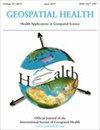马来西亚结直肠癌的空间聚类。
IF 0.9
4区 医学
Q4 HEALTH CARE SCIENCES & SERVICES
引用次数: 0
摘要
导读:结直肠癌(CRC)发病率的上升已成为全球关注的问题。由于CRC发病率的地理差异表明区域层面决定因素的作用,本研究旨在确定马来西亚社区层面CRC的空间分布格局。方法:从马来西亚国家癌症登记处确定2010年至2016年新诊断的结直肠癌病例。居住地址是地理编码的。随后进行聚类分析以检查结直肠癌病例之间的空间依赖性。还比较了集群之间个体的社会人口学特征的差异。根据人口背景将确定的群集分为城市和半农村地区。结果:纳入研究的18405人中,大多数为男性(56%),年龄在60至69岁之间(30.3%),仅在疾病的3期或4期就诊(71.3%)。显示有结直肠癌群集的州是吉打州、槟城、霹雳州、雪兰莪州、吉隆坡、马六甲、柔佛、吉兰丹和沙捞越。空间自相关检测出显著的聚类模式(Moran's Index 0.244, p< 0.01, Z score >2.58)。槟城、雪兰莪、吉隆坡、马六甲、柔佛和沙捞越的CRC集群位于城市化地区,而吉打州、霹雳州和吉兰丹的CRC集群位于半农村地区。结论:马来西亚城市化和半农村地区的几个集群的存在暗示了生态决定因素在邻里层面的作用。这些发现可用于指导政策制定者进行资源配置和癌症控制。本文章由计算机程序翻译,如有差异,请以英文原文为准。
Spatial clustering of colorectal cancer in Malaysia.
INTRODUCTION
The rise in colorectal cancer (CRC) incidence becomes a global concern. As geographical variations in the CRC incidence suggests the role of area-level determinants, the current study was designed to identify the spatial distribution pattern of CRC at the neighbourhood level in Malaysia.
METHOD
Newly diagnosed CRC cases between 2010 and 2016 in Malaysia were identified from the National Cancer Registry. Residential addresses were geocoded. Clustering analysis was subsequently performed to examine the spatial dependence between CRC cases. Differences in socio-demographic characteristics of individuals between the clusters were also compared. Identified clusters were categorized into urban and semi-rural areas based on the population background.
RESULT
Most of the 18 405 individuals included in the study were male (56%), aged between 60 and 69 years (30.3%) and only presented for care at stages 3 or 4 of the disease (71.3%). The states shown to have CRC clusters were Kedah, Penang, Perak, Selangor, Kuala Lumpur, Melaka, Johor, Kelantan, and Sarawak. The spatial autocorrelation detected a significant clustering pattern (Moran's Index 0.244, p< 0.01, Z score >2.58). CRC clusters in Penang, Selangor, Kuala Lumpur, Melaka, Johor, and Sarawak were in urbanized areas, while those in Kedah, Perak and Kelantan were in semi-rural areas.
CONCLUSION
The presence of several clusters in urbanized and semi-rural areas implied the role of ecological determinants at the neighbourhood level in Malaysia. Such findings could be used to guide the policymakers in resource allocation and cancer control.
求助全文
通过发布文献求助,成功后即可免费获取论文全文。
去求助
来源期刊

Geospatial Health
医学-公共卫生、环境卫生与职业卫生
CiteScore
2.40
自引率
11.80%
发文量
48
审稿时长
12 months
期刊介绍:
The focus of the journal is on all aspects of the application of geographical information systems, remote sensing, global positioning systems, spatial statistics and other geospatial tools in human and veterinary health. The journal publishes two issues per year.
 求助内容:
求助内容: 应助结果提醒方式:
应助结果提醒方式:


